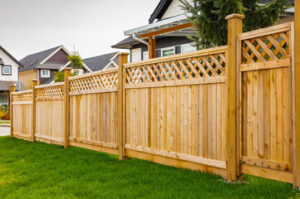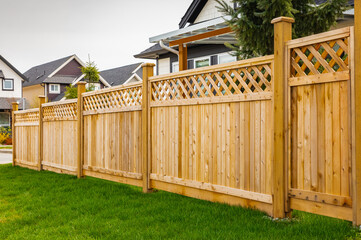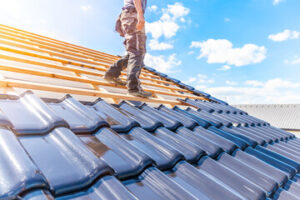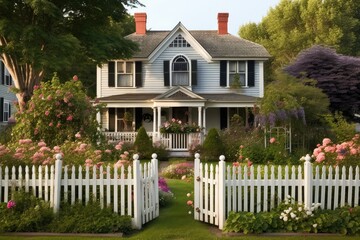A quality Wooden Privacy Fence can turn your backyard into a private outdoor retreat. It can also increase your home’s value.
Choose a type of wood to complement your landscape and fit your budget. Wood fences offer numerous design and style options, such as picket, post-and-rail, lattice, louver, shadow box, and stockade.
A beautiful wood fence can instantly spruce up your home’s curb appeal. It’s not just a nice addition; it also increases your home’s value and makes it easier to sell when you decide to move.
If you’re thinking about adding a wooden privacy fence to your home, there are several things you need to consider before getting started. First, make sure to have your property lines drawn up. You can use your home’s plat or hire a land surveyor to do this. Then, you’ll know where the fence will be installed and whether or not it will interfere with buried utility lines. Next, it’s a good idea to get a permit from your local city or county. Depending on your location, you may need one for construction or just to protect your fence from zoning issues. Finally, you should call your local utility companies to see if there are any underground utility lines in the area before digging post holes (about 2 feet into the ground).
Wooden fences come in a variety of sizes, uses, and materials. They can be painted or stained to match your home’s aesthetic. They can be crafted in many styles, including classic white picket, lattice fences, and more modern horizontal panels. They can be used to create a perimeter around your entire yard or to enclose a specific section, like a garden plot or pool.
Some fences are designed for maximum privacy, while others are built to look aesthetically pleasing. For example, a stockade fence is made with tightly-fitted panels that are set close together for complete privacy. A shadow box fence has staggered boards that overlap by about one-third of their width, creating an alternating pattern of partial visibility and privacy between adjacent panels. Lattice can be added to these designs for a more decorative look.
Other types of wood fencing include a cap and trim, a t-post and rail design, and board-on-board fences. Whatever style you choose, a fence is a great way to add beauty and curb appeal to your home and is an investment that can pay off in the long run when it comes time to sell.
Privacy
A privacy fence offers the benefit of blocking outsiders from seeing into your yard and home. It can prevent neighbors from observing your activities, kids playing, and pets roaming your property. The tightly connected slats of wood fencing also absorb sound, which can be beneficial in quiet neighborhoods where noise is an issue. Moreover, a privacy fence blocks wind, which can be helpful in cold climates.
Wooden fences are a popular choice for privacy because of their sturdy construction and beautiful appearance. They are available in a variety of styles and can be stained or painted to match your home’s aesthetic. A wood fence can last 20 years or more, depending on how well it is maintained and the weather conditions where you live.
To qualify as a privacy fence, a wood fence must obstruct visibility from one side to the other and have few or no gaps. The height of a privacy fence is also a factor. A taller wooden fence is more effective than a shorter one. A taller fence can reduce visibility from a greater distance.
Other factors that affect the privacy of a wooden fence include the material used to construct it and any spacing between slats. A solid brick or aluminum fence is highly private, while a chain-link fence is not because it has large spaces between the infill panels.
The infill panel or boards of a privacy fence are the most visible part of the fence, which is why they require the most regular maintenance. A wooden fence must be regularly repainted or re-stained to keep it looking new. This is an ongoing chore and can become expensive if you have a large fence.
When building a privacy fence, you should always check with local utilities to make sure that you are not digging into any buried lines. Post holes for a wood fence must be dug at least 2 feet into the ground, which may require professional installation and equipment like a post hole digger or auger.
Durability
A wood privacy fence can last about 15 years, but the lifespan depends on the material used and how well it is maintained. Western red cedar is a popular choice for backyard fencing because it naturally resists rot and decay. It also doesn’t shrink and is impervious to moisture, which can damage other types of wood. Other common fencing materials include pine, which is often chemically treated for fence use. It can last for a while but will need to be replaced more frequently than other woods.
Whether you choose cedar, pine, or another type of wood for your fence, it’s important to regularly stain or paint it to keep it looking good and to protect the wood from rot and insects. A water-repellent preservative or sealant should be applied every two to four years. This helps limit the growth of mold, fungus, and warping and keeps the wood from becoming damaged by UV rays.
Other factors that can affect the longevity of a wood fence include how often it is cleaned, how often sprinklers are used, and whether shrubs and vines are allowed to grow near the fence. It’s a good idea to regularly inspect your wood fence and treat any insect infestations right away.
Wood fences are available in a variety of styles, including picket, louvered, board-on-board, shadow box, lattice, post-and-rail, and scalloped. They are also easy to customize by painting and staining them to match your home. Wooden fences are also simple to repair, and you can replace individual boards that have become warped or damaged rather than replacing the entire structure. This makes wooden fences one of the most affordable and versatile fencing options for homeowners.
Maintenance
Wooden fences are a great way to add privacy and enhance curb appeal, but they require regular maintenance to keep them looking good. The first step in preserving your fence is to clean it regularly using a soft brush or a power washer without adding harsh chemicals that can damage the surface of the wood. After washing, use a mildew remover to eliminate any spots of mold and mildew that remain. Similarly, you should check for rust and other signs of corrosion on metal components of the fence and use a rust remover to correct the problem.
Next, you should trim any plants that are growing too close to the fence. This prevents the plants from exerting pressure on the wall, which can cause it to rot or become damaged by pests or weather over time. It also helps to maintain adequate space between the plant growth and the fence, which reduces moisture accumulation and the risk of pests or insects damaging the walls.
A final part of the maintenance process is staining the wooden fence. Stains are available in a variety of colors, and many home improvement and hardware stores sell water-repellent preservatives or sealants that homeowners can apply to their fences to protect them from the elements. If your fence is made from pressure-treated wood, however, a stain or sealant may not be necessary because the wood has already been injected with preservatives.
When it comes to staining, you should choose oil stains instead of paint because the latter cannot withstand exposure to the sun, rain, and other harsh environmental conditions. Using a wood stain that includes a UV blocker will help to prevent the wood from bleaching, which will make it look faded and unattractive. It is recommended to re-stain your wooden fence every couple of years, although some people prefer to stain it less often or even wait longer to do so.




